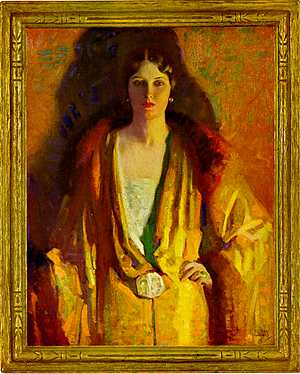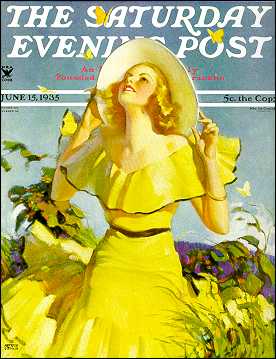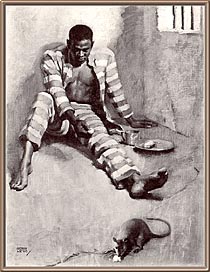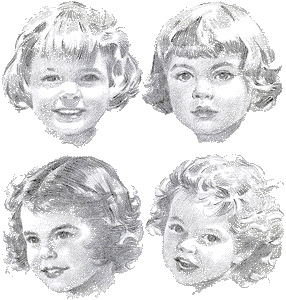



|

|
 When
I was selling books for a living, I sold 141 copies of Loomis'
Figure Drawing For All It's Worth in less than 20 years. It's still in print today - 60+ years
after publication. That's a pretty ringing endorsement for his
teaching skills.
When
I was selling books for a living, I sold 141 copies of Loomis'
Figure Drawing For All It's Worth in less than 20 years. It's still in print today - 60+ years
after publication. That's a pretty ringing endorsement for his
teaching skills.
Loomis was born in 1892 in Syracuse, New York. Walt and Roger Reed in The Illustrator in America say that "it was a visit to the nearby studio of Howard Chandler Christy that made him decide to seek for himself an artist's career." He studied in New York at the Art Students League under George Bridgman and F.V. du Mond when he was 19 and went back to the Midwest (he grew up in Zanesville, Ohio) in 1915 to Chicago to work in an art studio there. He continued his education at the Chicago Art Institute.

![]() After military service in World War I, Loomis
worked for a couple of advertising agencies before opening his
own studio at 360 North Michigan Avenue in downtown Chicago where
he listed his "subjects" as "Character Studies,
Figures, Historical Subjects, Interiors, Covers, Posters, Portraits,
Still Life, Landscapes" and his "mediums" as "Black
and white, Charcoal, Color, Dry Brush, Oil, Watercolor, Pastel,
Wash." At left is a sample of his work from 1928.
After military service in World War I, Loomis
worked for a couple of advertising agencies before opening his
own studio at 360 North Michigan Avenue in downtown Chicago where
he listed his "subjects" as "Character Studies,
Figures, Historical Subjects, Interiors, Covers, Posters, Portraits,
Still Life, Landscapes" and his "mediums" as "Black
and white, Charcoal, Color, Dry Brush, Oil, Watercolor, Pastel,
Wash." At left is a sample of his work from 1928.
 At
right is his only cover for The Saturday Evening Post,
from 1935. (Image from The Illustrator in America: 1880-1980)
He produced commercial art his entire career, but it was as a teacher, more than as an illustrator, that he made a very lasting impression upon the artists that came after him.
At
right is his only cover for The Saturday Evening Post,
from 1935. (Image from The Illustrator in America: 1880-1980)
He produced commercial art his entire career, but it was as a teacher, more than as an illustrator, that he made a very lasting impression upon the artists that came after him.

He taught at the American Academy of Art, in Chicago, during the 1930s and it was there he perfected the teaching techniques that he codified in his first book, Fun With a Pencil, in 1939. The self-portrait/caricature at the top of this page is the final illustration in that book. It's 120 pages in b&w and blue and the focus is cartooning, though there are lots of very solid illustration tips as well. And it really is fun! The tone is light-hearted, but the information is carefully and skillfully presented. It's no surprise that it was popular.
And it was very popular! By 1943 it had gone through six printings. This response was sufficient to induce Loomis to write another instructional book that year, the ever-popular Figure Drawing For All It's Worth, mentioned above. I use the phrase "ever-popular" advisedly as by 1973 the book was in its 25th printing, and the fact that I sold so many copies is due to the continued demand from artists, young and old, who want to take advantage of the seminal content. It's an amazing book that actually lives up to its reputation. It's 204 pages of solid anatomy for illustrators, profusely illustrated, primarily with pencil drawings. By 1946 it was in its 12th printing.
 The
next book would be his masterpiece. The 1947 Creative Illustration
was aimed at the professional illustrator. It was 300 pages divided
into seven sections: Line, Tone and Color
were the three introductory parts. Then came the four sections
that make this book still relevant today - Telling the Story,
Creating Ideas, Fields of Illustration, and Experimenting
and Studies.
The
next book would be his masterpiece. The 1947 Creative Illustration
was aimed at the professional illustrator. It was 300 pages divided
into seven sections: Line, Tone and Color
were the three introductory parts. Then came the four sections
that make this book still relevant today - Telling the Story,
Creating Ideas, Fields of Illustration, and Experimenting
and Studies.
 The
Color section was in color - definitely not
a common practice at that time. The page at right shows a variety
of tonal studies from palettes based on color schemes. The book
is filled with instructions, tips, insider experiences, and incredible
illustrations.
The
Color section was in color - definitely not
a common practice at that time. The page at right shows a variety
of tonal studies from palettes based on color schemes. The book
is filled with instructions, tips, insider experiences, and incredible
illustrations.
Telling the Story leads off with the powerful image at left, a story in itself. Every chapter, every page, every picture is prime information for the artist and Loomis manages to convey it clearly and concisely. Creative Illustration is a dynamite book!
In 1951 he released Successful Drawing with more advanced fundamentals. This title was re-released in a slightly altered form in 1961 as Three-Dimensional Drawing. Drawing
the Head and Hands was next, in 1956. It took the information
presented in Fun With a Pencil and Figure Drawing For
All It's Worth, expanded it, clarified it, and presented it
in 155 pages of new text and art. The importance of this title
in the Loomis canon can't be emphasized enough, and students are
still clamoring for copies, even with prices over $100.
Drawing
the Head and Hands was next, in 1956. It took the information
presented in Fun With a Pencil and Figure Drawing For
All It's Worth, expanded it, clarified it, and presented it
in 155 pages of new text and art. The importance of this title
in the Loomis canon can't be emphasized enough, and students are
still clamoring for copies, even with prices over $100.
Which leads us inevitably into the question of why aren't these books being reprinted? All I can say is "I don't know." I've heard all kinds of rumors and speculations, but the purpose of these pages is not to deal with anything other than facts, so it's still as much a mystery to me as it is to you. The Walter T. Foster company seems to have some access to the material from some of the books and Titan has recently (2010) reprinted Figure Drawing For All It's Worth.
The elusive and intriguingly titled Eye of the Painter and Elements of Beauty is Loomis' last book, published posthumously in 1961, two years after his death. It's his treatise on how an artist perceives beauty and harmony. It's an interesting book, but it's not for casual perusal and doesn't have all that much Loomis art. It's mainly illustrated with samples of the work of fine artists..
 To learn more about Andrew Loomis, visit Monte Wilson's
Loomis
Page, or see:
To learn more about Andrew Loomis, visit Monte Wilson's
Loomis
Page, or see:
| The Illustrator in America: 1880-1980 | Walt and Roger Reed, 1984 Madison Square Press |
| Andrew Loomis: A Legacy in Words and Pictures | Jack E. Harris, Jr. 2000 Syracuse University |
| The Illustrator in America: 1860-2000 | Walt and Roger Reed, 2001 Watson Guptill |
| The Vadeboncoeur Collection of Knowledge | Jim Vadeboncoeur, Jr. 1998 |
|
Illustrations are copyright by their respective owners. This page written, designed & © 1998 by Jim Vadeboncoeur, Jr. Updated 2011. |
